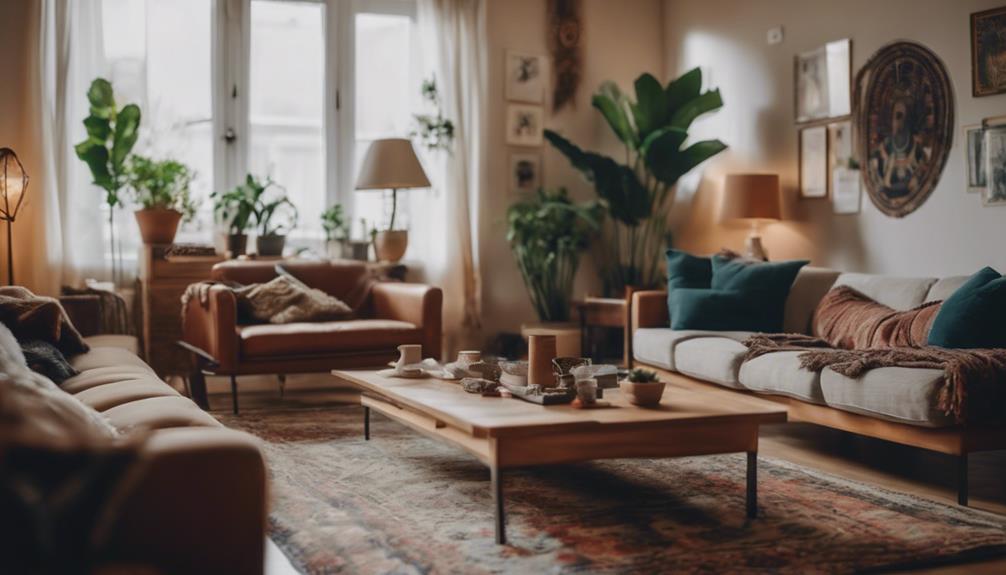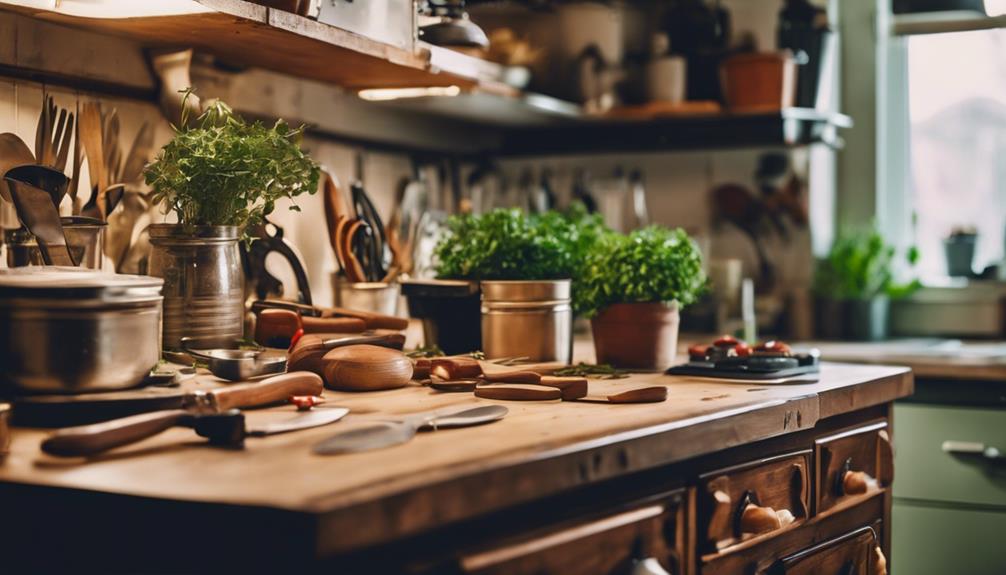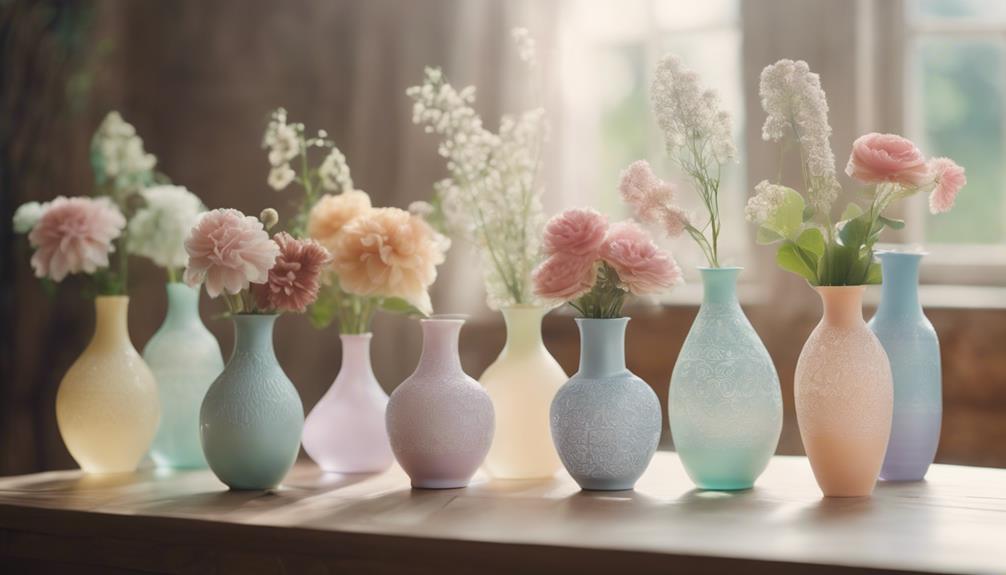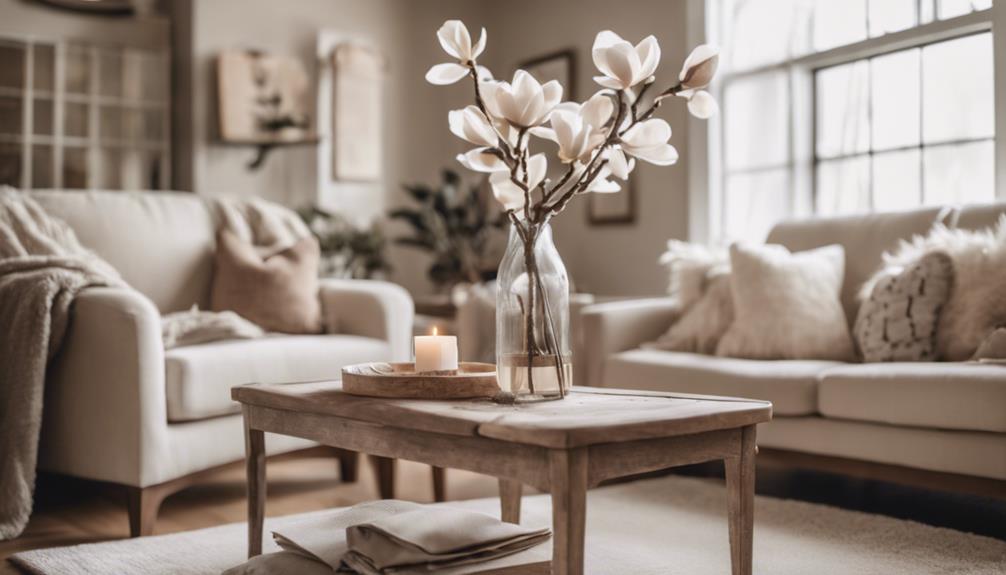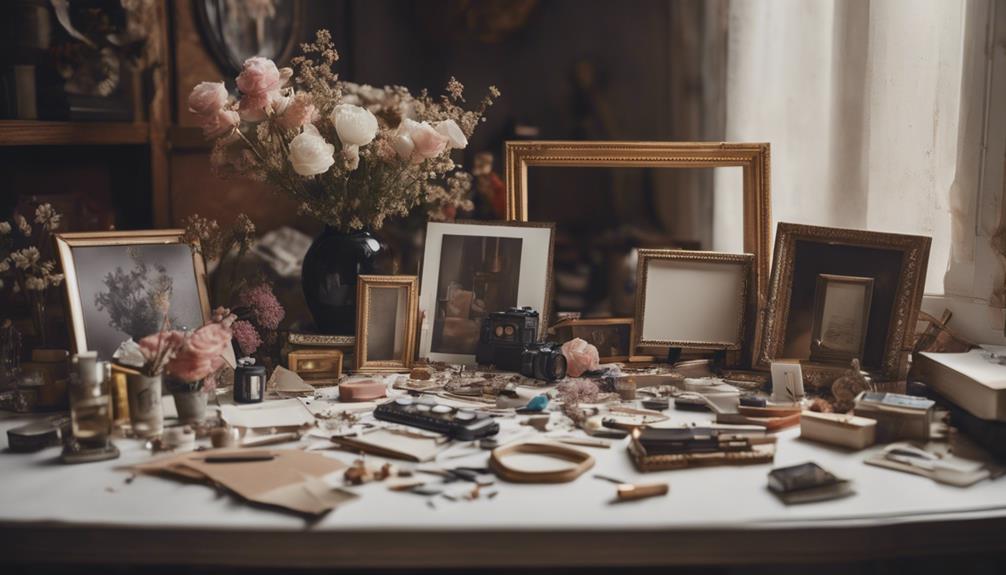Discover your interior decorating style by defining your design preferences, exploring your color palette, embracing minimalist elements, incorporating natural materials, and learning various furniture arrangement techniques. Balance your space with Feng Shui principles, infuse it with personal touches, and reflect your unique personality through decor. Create harmony in your home by finding a cohesive balance in all aspects of your design choices. By understanding these key elements, you'll be able to transform your space into a reflection of your style and preferences. Dive deeper into each aspect to elevate your interior decorating skills and create a space you'll love.
Key Takeaways
- Take the Havenly Style Quiz for personalized style recommendations.
- Consider color psychology to harmonize your color palette.
- Incorporate minimalist elements for simplicity and elegance.
- Use natural materials like wood and stone for warmth.
- Infuse personal touches to make your space uniquely yours.
Define Your Design Preferences
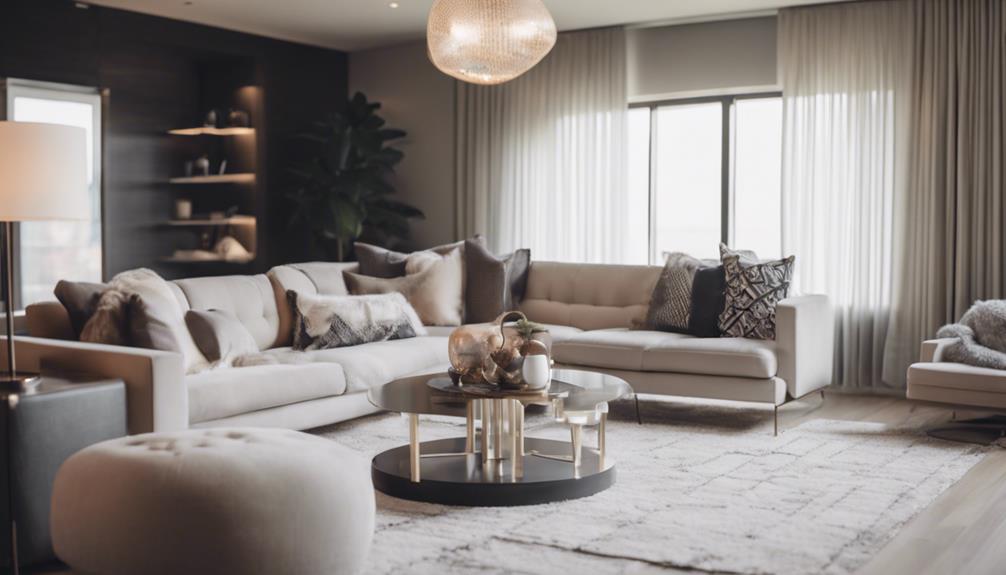
To explore your interior decorating style, we'll guide you through the Havenly Style Quiz, helping you uncover whether your preference leans towards Bohemian, Glam, or Midcentury Modern.
This style quiz delves into various aspects of interior design, from color choices to furniture preferences, to determine which design aesthetic resonates most with you. By understanding your design preferences, the quiz can provide personalized results that align with your unique style and taste.
Whether you're drawn to the eclectic and free-spirited Bohemian style, the luxurious and elegant Glam style, or the sleek and retro Midcentury Modern style, the quiz aims to capture the essence of your interior design leanings.
Once you have identified your design preferences through the quiz, you can then match with a Havenly designer who can further assist you in creating a home that reflects your individuality and vision.
Take the first step in crafting a space you love by discovering your interior decorating style through this insightful quiz.
Discover Your Color Palette
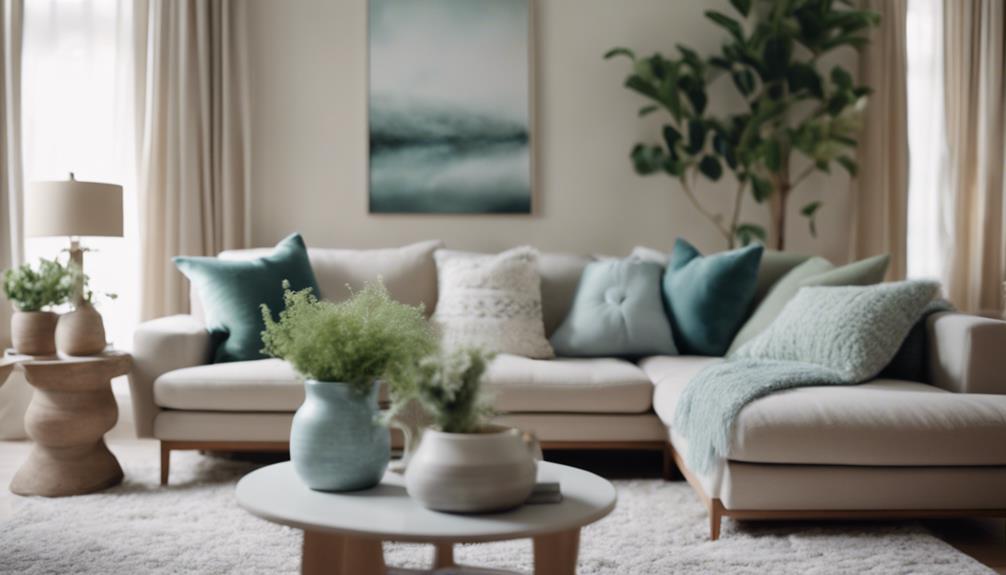
When deciding on your color palette, it's crucial to take into account your personal preferences and style to create a cohesive look.
Explore different color combinations to achieve a harmonious atmosphere in your space.
Utilize color psychology to understand how different shades can impact emotions and perceptions within a room.
Color Psychology Basics
Exploring color psychology basics can empower you to discover your ideal color palette for interior decorating. Understanding how colors influence emotions and moods is vital in creating the right ambiance for your space. Check out the table below for a quick guide on the psychological effects of different colors in interior design:
| Color | Psychological Effect |
|---|---|
| Blue | Calmness and Serenity |
| Red | Energy and Passion |
| Yellow | Warmth and Coziness |
| Orange | Welcoming Atmosphere |
| Green | Relaxation and Tranquility |
| Purple | Creativity and Luxury |
Personal Color Preferences
Discovering your ideal color palette for interior decorating can be facilitated by understanding your personal color preferences. By taking a Personal Color Preferences quiz, you can uncover your unique color palette that resonates with your design style. Consider the following to help determine your preferred color scheme and create a cohesive look for your space:
- Reflect on Your Favorite Colors: Identify hues that you naturally gravitate towards in your wardrobe or surroundings.
- Consider the Mood You Want to Create: Think about the atmosphere you wish to achieve in each room.
- Explore Different Color Combinations: Experiment with various shades to find what complements each other best.
- Understand Color Psychology: Learn how different colors can influence emotions and perceptions in a space.
Harmonizing Color Schemes
To create a harmonious interior decor, selecting a cohesive color palette is essential for ensuring a visually appealing and unified space. Finding your color palette involves understanding your personal style and preferences. By taking a style quiz or exploring different color combinations, you can discover the colors that resonate with you.
Coordinating these colors in your decor can greatly enhance the overall look and feel of a room. It's important to choose colors that not only complement each other but also reflect the mood and atmosphere you want to create. Understanding color theory can guide you in selecting complementary colors for a balanced design scheme.
Experimenting with various shades and tones within your chosen palette can help you achieve a cohesive and stylish interior decor.
Embrace Minimalist Elements
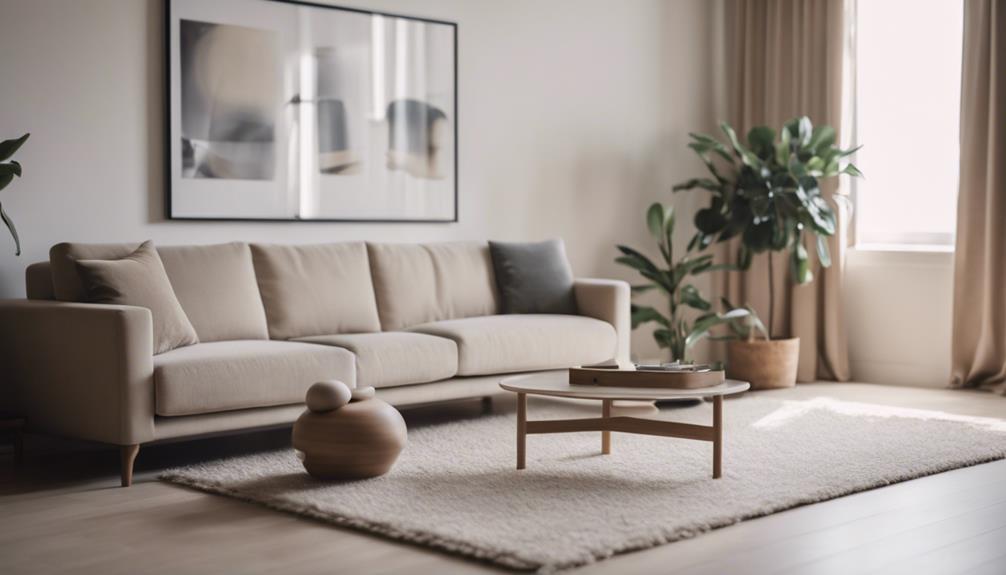
Let's simplify our interior design approach by incorporating clean lines, decluttering our spaces, and focusing on the essentials.
By embracing minimalist elements, we can create open and spacious environments that promote a sense of calm and tranquility.
Neutral color palettes, sleek furniture pieces, and minimal accessories are key components to achieve a minimalist aesthetic.
Simplify With Clean Lines
Simplicity and elegance are effortlessly achieved in interior design by embracing minimalist elements and clean lines. To create a space that exudes a sense of calm and sophistication, consider the following:
- Focus on Function: Prioritize functionality over unnecessary decor to maintain a clean and purposeful look.
- Streamline Furniture: Opt for pieces with sleek, straight lines to enhance the overall aesthetic and promote an uncluttered feel.
- Neutral Color Palette: Choose neutral tones like whites, greys, and beiges to complement the minimalist style and create a serene atmosphere.
- Limit Decor: Select a few key decor items that have a significant impact rather than overcrowding the space with numerous accessories.
Declutter for Open Space
In embracing minimalist elements for open space, we focus on decluttering to create a sense of tranquility and spaciousness. Minimalist design aims for simplicity, functionality, and clean lines to foster a calm atmosphere.
By removing excess items and unnecessary decorations, key design elements can shine, enhancing a room's visual appeal. This approach not only organizes the space efficiently but also provides a visually soothing environment for residents and guests.
Decluttering for open space in interior design contributes to a modern and sophisticated aesthetic while reducing visual distractions in the home. To find your interior design style, consider taking a Design Quiz to get personalized recommendations based on your preferences and needs.
Focus on Essentials
To create a serene and visually appealing interior, embracing minimalist elements involves simplifying design to focus on essential features and functionality. When incorporating minimalist elements into your decor, consider the following:
- Clean Lines: Opt for furniture and decor with sleek, straight lines to maintain a sense of simplicity and sophistication.
- Neutral Colors: Choose a muted color palette consisting of whites, grays, and earth tones to create a calming ambiance.
- Uncluttered Spaces: Keep surfaces clear of excess items to promote a feeling of openness and tranquility.
- Quality Over Quantity: Select a few high-quality pieces that serve a purpose rather than filling the space with unnecessary items.
Incorporate Natural Materials
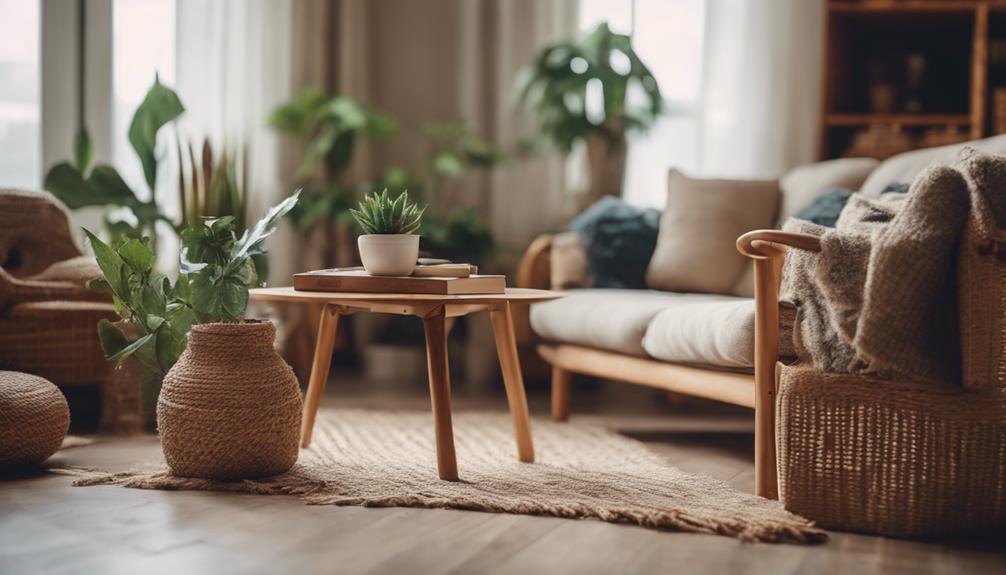
Incorporating natural materials like wood, stone, and leather enhances the warmth and texture of your space. These elements not only add visual interest but also create a cozy atmosphere that invites relaxation. By bringing nature indoors, you establish a sense of harmony and connection with the environment.
| Natural Material | Benefits | Styles |
|---|---|---|
| Wood | Adds warmth and versatility | Rustic, Modern, Scandinavian |
| Stone | Provides texture and durability | Mediterranean, Industrial |
| Leather | Offers richness and elegance | Mid-Century Modern, Traditional |
Using natural materials is a timeless design choice that can complement various interior styles, from the classic elegance of traditional decor to the sleek lines of modern design. Additionally, opting for sustainable materials aligns with eco-friendly practices, contributing to a greener lifestyle. So, consider incorporating natural elements into your decor to create a space that reflects your style while connecting you to the beauty of the natural world.
Explore Furniture Arrangement Techniques
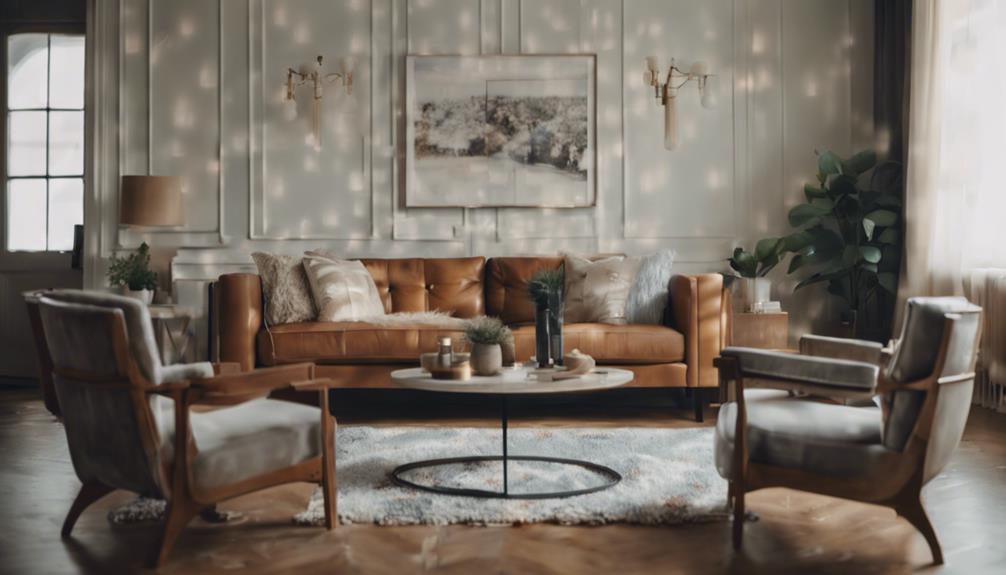
When arranging furniture, we consider various seating layout options to best utilize the space.
We also take into account artwork placement tips to enhance the overall aesthetic.
Functional furniture arrangements play a key role in optimizing both comfort and style in our living areas.
Seating Layout Options
Exploring different seating layout options allows us to maximize functionality and create various atmospheres within a room. When contemplating seating arrangements, it's crucial to grasp how different setups can impact the flow and feel of a space.
Here are four key seating layout options to ponder:
- Conversational Arrangement: Ideal for promoting interaction, this layout often involves placing seating facing each other to encourage conversation.
- Symmetrical Layout: Achieving balance and harmony, this setup involves placing identical seating elements on either side of a focal point.
- Floating Furniture: This layout involves pulling furniture away from walls, creating a more open and spacious feel in the room.
- Sectional Seating: Perfect for large spaces, sectionals offer ample seating and can help define separate areas within a room.
Artwork Placement Tips
Let's explore effective techniques for placing artwork within a room while taking into account furniture arrangement. Proper artwork placement can greatly enhance the overall aesthetic of a space.
When deciding where to hang artwork, it's important to take into account the size and scale of the pieces in relation to the available wall space. Aim to position artwork at eye level, ensuring it's easily visible and appreciated.
To create visual balance, space out artwork evenly on the walls rather than clustering them all in one area. Don't be afraid to experiment with different arrangements to find the most visually appealing layout for your room.
Functional Furniture Arrangements
To optimize the functionality and appeal of a room, mastering effective furniture arrangement techniques is crucial. When arranging furniture, consider the following:
- Functionality: Guarantee that the furniture layout serves its purpose and allows for easy movement within the space.
- Balance: Create a visually pleasing arrangement by distributing furniture evenly throughout the room.
- Space Utilization: Maximize the use of space by strategically placing furniture to avoid overcrowding or leaving empty areas.
- Enhancement: Explore ways to enhance both the functionality and aesthetics of the room through thoughtful furniture arrangement.
Infuse Personal Touches
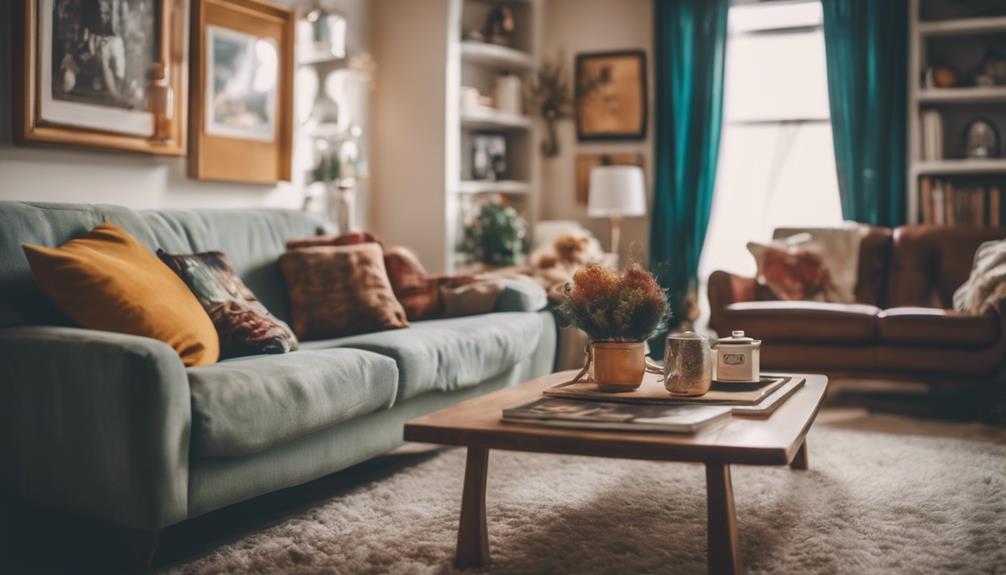
Adding personal touches to your interior decorating brings a sense of warmth and individuality to your space. By infusing elements like family photos, travel souvenirs, or handmade items, you can create a home that feels uniquely yours. These personal touches not only make your space more inviting but also allow you to showcase your personality and interests. Whether it's a cherished memento from a special trip or a DIY creation, personalized decor items can serve as conversation starters and add character to your home.
When you incorporate personal touches into your interior design, you're transforming your space into a reflection of who you are. Your home becomes a place that not only looks beautiful but also feels warm, welcoming, and authentically yours. So, don't be afraid to display those family heirlooms, hang up those meaningful artworks, or set out those handmade decorations. Embrace your individual style and let your personality shine through in every corner of your living space.
Balance With Feng Shui Principles
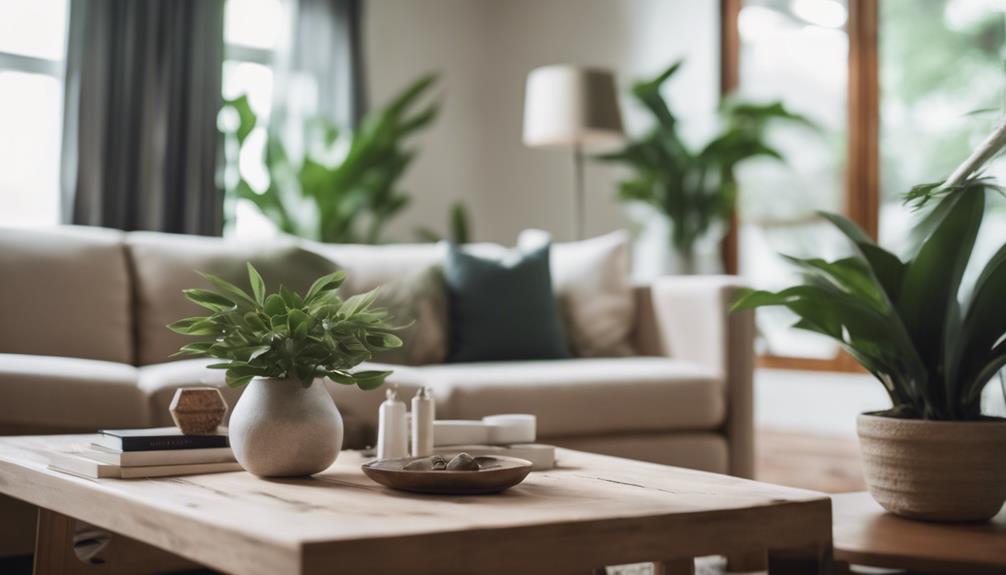
Infusing personal touches into your interior design can be enhanced by incorporating Feng Shui principles to achieve a harmonious and balanced environment in your home. Feng Shui focuses on creating a space that promotes positive energy flow, ultimately contributing to your well-being. By following these principles, you can create a tranquil and inviting atmosphere within your living space.
Here are four ways to incorporate Feng Shui principles into your home:
- Arrange Furniture Thoughtfully: Position furniture to allow for smooth movement and clear pathways. Avoid blocking doorways or placing furniture in direct lines of entry.
- Use Color Mindfully: Select colors that promote relaxation and balance. Earthy tones like beige, green, or blue can create a calming ambiance.
- Integrate Natural Elements: Bring in elements from nature such as plants, stones, or wooden decor to connect with the earth's energy.
- Declutter and Organize: Keep your space tidy and free of clutter to allow energy to flow freely throughout your home.
Create a Calm Atmosphere
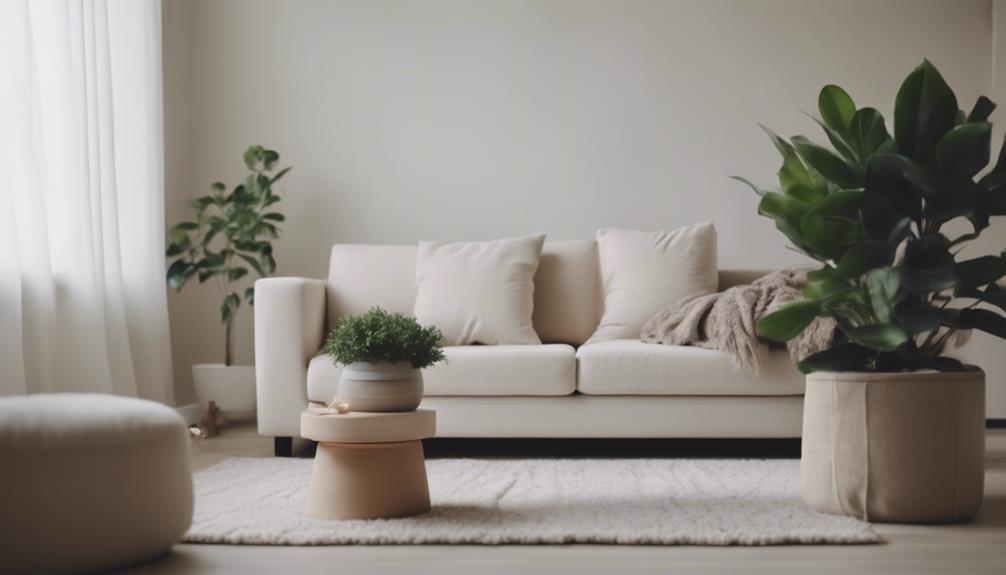
Let's establish a serene ambiance by incorporating soft, soothing colors and natural elements into the space. To create a calm atmosphere in your home, consider using colors like blues, greens, and neutrals. These hues have a relaxing effect on the mind and can help promote a sense of tranquility. Additionally, incorporating natural elements such as wood, stone, and plants can further enhance the peaceful vibe of the room.
When selecting furniture pieces, opt for items that are comfortable and cozy. Having furniture that promotes relaxation and comfort can greatly contribute to the overall calming atmosphere of the space. It's also important to minimize clutter and keep the area organized. A neat and tidy space can help maintain a peaceful environment.
To set a calming mood in the room, consider using soft lighting options like ambient, task, and accent lighting. Soft lighting can create a warm and inviting atmosphere that's perfect for unwinding after a long day.
Reflect Your Personality Through Decor
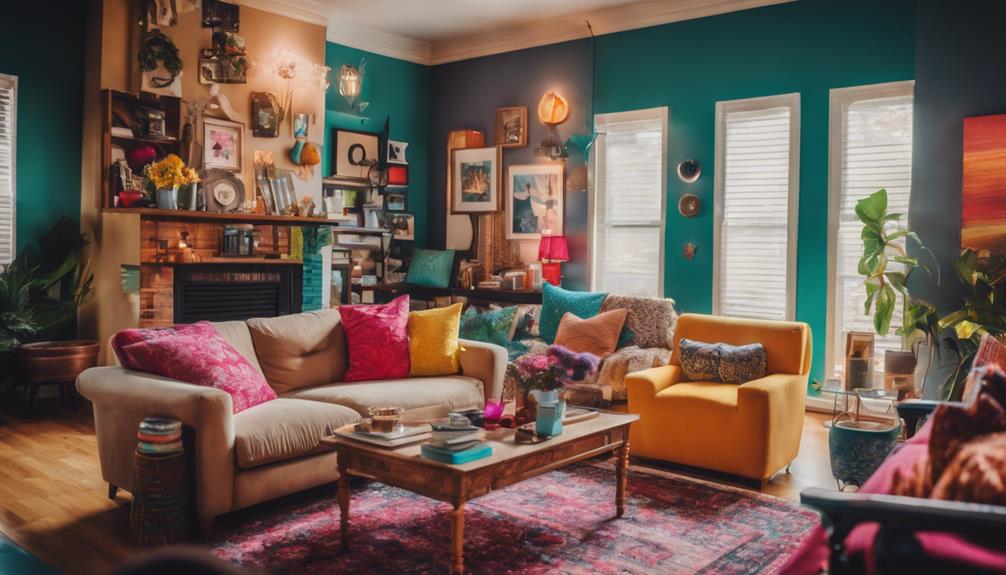
To truly make your living space feel like your own, it's important to reflect your personality through the decor choices you make. Your home should be a reflection of who you are, showcasing your unique tastes and interests. Here are four ways to infuse your personality into your decor:
- Choose Decor Elements that Resonate with You: Select items that bring you joy and comfort, whether it's through colors, patterns, or objects that hold special meaning to you.
- Incorporate Colors, Textures, and Furniture that Express Your Individuality: Use a mix of hues and textures that speak to your personal style, and select furniture pieces that align with your preferences, whether modern, vintage, or eclectic.
- Showcase Your Interests, Hobbies, and Memories: Display items that represent your passions, whether it's artwork, souvenirs from travels, or photographs that hold cherished memories.
- Create a Personalized Gallery: Curate a gallery wall featuring artwork, photographs, and mementos that tell your story and create a warm and inviting atmosphere in your home.
Find Harmony in Your Home
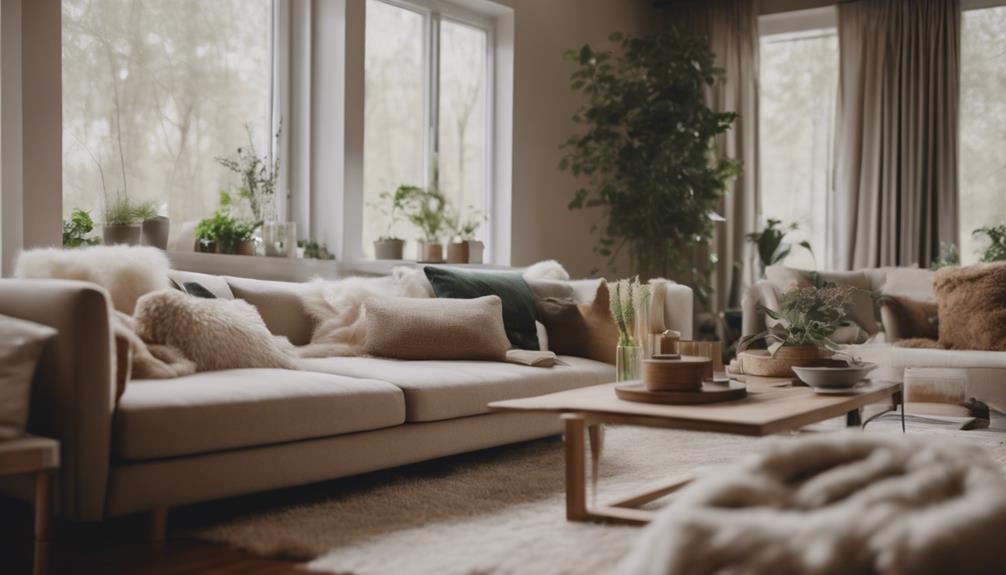
Identifying your interior design style is crucial in achieving a harmonious atmosphere in your home. Taking a style quiz can help pinpoint whether you lean towards Bohemian, Glam, or Midcentury Modern aesthetics. By uncovering your unique design preferences, you can work towards creating a space that truly reflects your personality.
Partnering with a design service like Havenly can streamline the process of harmonizing your home. Their personalized approach focuses on bringing out your individuality while offering professional guidance tailored to your budget and style. Client testimonials rave about Havenly's ability to save time, incorporate existing furniture, and maximize space functionality, resulting in seamless design experiences.
Embrace the potential of your home by gradually transforming it to align with your design style. Utilize resources like quizzes and design inspiration to guide you in creating a dreamy and harmonious living space that you'll love coming home to.
Frequently Asked Questions
How Do You Define Your Decorating Style?
When defining our decorating style, we consider our preferences in colors, patterns, furniture, and overall aesthetic. It's important to reflect our personality and create a space that feels comfortable and inviting.
How Do I Work Out My Interior Style?
We find our interior style by exploring various design elements like color palettes, furniture styles, and decorative accessories. Consider your preferences for cozy vs. sleek, vibrant vs. neutral, and classic vs. contemporary.
Experiment with different combinations until you discover what resonates with you. Don't be afraid to mix and match different styles to create a unique look that reflects your personality.
Explore, experiment, and trust your instincts when defining your interior design style.
What Is the Interior Design Style?
We can define interior design style as the specific aesthetic approach or theme that characterizes a space's decor. It encompasses elements like color schemes, furniture choices, and overall design concepts.
Each style, whether Bohemian, Glam, or Midcentury Modern, has distinct features that set it apart. Understanding the nuances of these styles can help you create a cohesive and personalized look for your home.
How Do You Describe Interior Decorations?
When describing interior decorations, we focus on the elements that shape a space's ambiance and aesthetics. These include:
- Furniture placement,
- Color schemes,
- Lighting choices, and
- Decorative accents.
By carefully selecting and arranging these components, we can create a pivotal and visually appealing environment that reflects our personal style and preferences.
Each piece plays an essential role in transforming a room into a welcoming and harmonious living space.
Conclusion
To sum up, discovering your interior decorating style involves defining your preferences, exploring color palettes, incorporating minimalist elements, natural materials, and furniture arrangement techniques.
Balancing Feng Shui principles and creating a calm atmosphere are essential for a harmonious home. Reflecting your personality through decor is key to making your space truly yours.
One interesting statistic to note is that 85% of people feel that their home decor reflects their personality and style.
